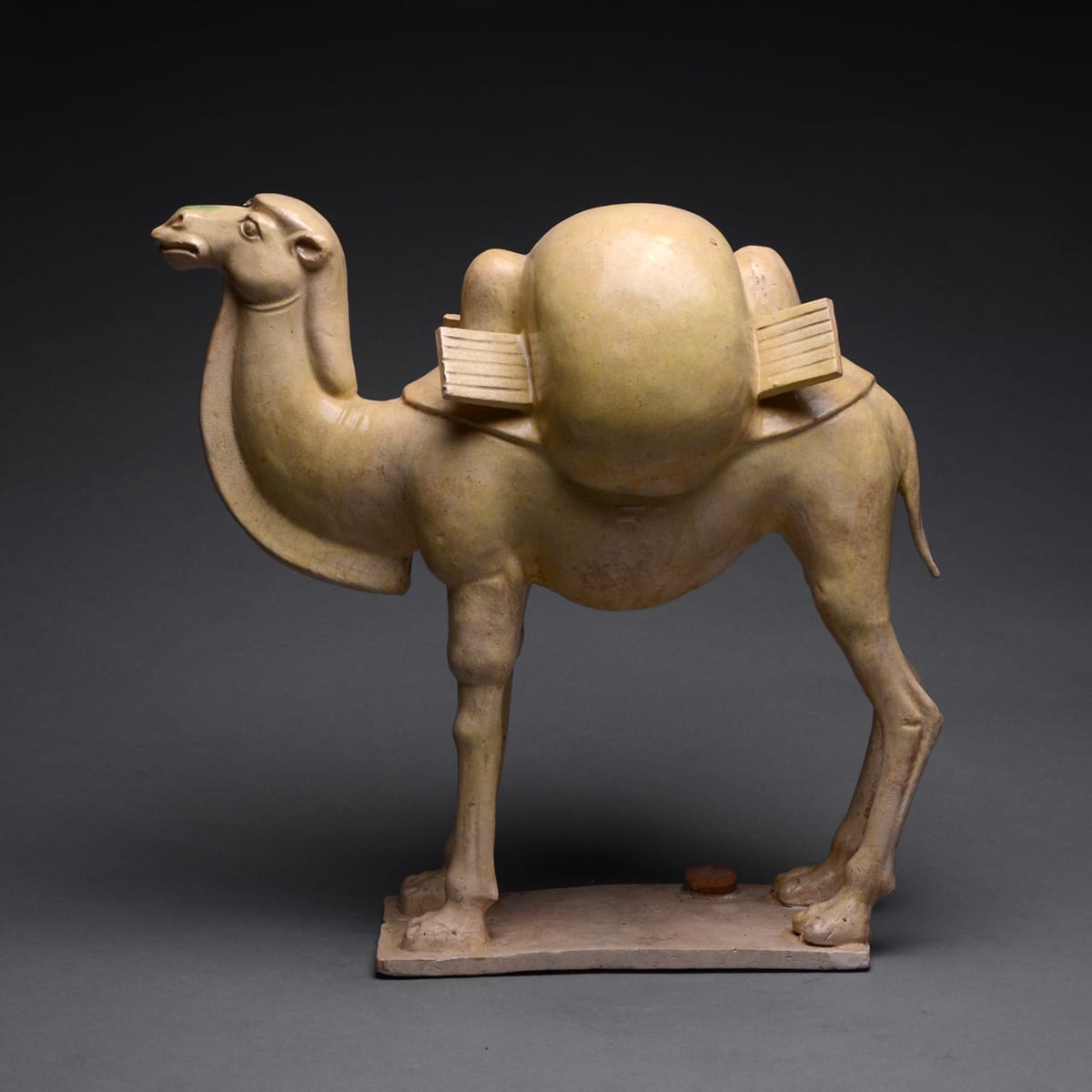Sui Glazed Terracotta Sculpture of a Camel, 581 CE - 618 CE
Glazed Terracotta
height 34.3 cm
height 13 1/2 in
height 13 1/2 in
H.724
Further images
After almost four hundred years of civil war and division, Yang Jian succeeded in reunifying north and south under one authority, the Sui Dynasty. However, despite its brief duration, lasting...
After almost four hundred years of civil war and division, Yang Jian succeeded in reunifying north and south under one authority, the Sui Dynasty. However, despite its brief duration, lasting for the rule of only two emperors, the Sui Dynasty paved the way for the cultural renaissance that would arise during the T’ang Dynasty. Reforms were introduced to wrest power out of the hands of the aristocracy, military, and Buddhist communities. The Confucianist system of selecting government officials from state schools, by means of rigorous examinations, was initiated. Perhaps their most significant program was the construction of the Great Canal, a project that facilitated the movement of people and goods across great distances, aiding in the reunification of China. However, the cost of the Canal bankrupted the empire and ultimately led to its dissolution, coupled with a failed campaign to conquer Korea. The rulers of the T’ang would capitalize on the infrastructure improvements of the Sui and establish one of the greatest empires in the history of China, following the footsteps of the Sui.
Th camel is an unusual domestic animal; it carries a saddle of flesh on its back;
swiftly it dashes over the shifting sands; it manifests its merit in dangerou places; it has a secret understanding of springs and sources, subtle indeed i its knowledge.
--Gu Pu, 3 Century AD
Camels symbolized commerce and its associate wealth, largely concentrated on profits through trading on the Silk Road. Trade across this extensive network of trails brought prosperity, foreig merchants, and exotic merchandize into the heart of China. However, the dusty trails of the Silk Road were an arduous journe through the rugged mountains and harsh desert of Central Asia that could only b traversed by the two humped Bactrian camel. The government kept vast herds of these invaluable creatures, preside over by civil officials, for hauling their precious commodities across the Sil Road. Camels were a common sight i the cosmopolitan cities of China, carrying both traders and their goods directl into the markets. Likewise, artis began to create charming representations of these prized creatures as
in order to symbolize wealth and prosperity in the afterlife. were works of art created in an ancient Chinese custo specifically for interment in the tombs of elite individuals in order to provid for their needs in the afterlife. Som of the most beautiful works of Chinese art were excavated from such tombs, an this crème-glazed sculpture of a camel, loaded with a swollen bundle of goods,
is a perfect example of the refined artistry dedicated to such works, despit the facts that they were not intended to be viewed by the living. Most remarkable, this work still retains some of its original painte pigment, including red highlights on his ears and mouth, which heighten th naturalism. This majestic sculptur reveals China’s respect and admiration for this beast of burden, so essentia to their prosperity.
Th camel is an unusual domestic animal; it carries a saddle of flesh on its back;
swiftly it dashes over the shifting sands; it manifests its merit in dangerou places; it has a secret understanding of springs and sources, subtle indeed i its knowledge.
--Gu Pu, 3 Century AD
Camels symbolized commerce and its associate wealth, largely concentrated on profits through trading on the Silk Road. Trade across this extensive network of trails brought prosperity, foreig merchants, and exotic merchandize into the heart of China. However, the dusty trails of the Silk Road were an arduous journe through the rugged mountains and harsh desert of Central Asia that could only b traversed by the two humped Bactrian camel. The government kept vast herds of these invaluable creatures, preside over by civil officials, for hauling their precious commodities across the Sil Road. Camels were a common sight i the cosmopolitan cities of China, carrying both traders and their goods directl into the markets. Likewise, artis began to create charming representations of these prized creatures as
in order to symbolize wealth and prosperity in the afterlife. were works of art created in an ancient Chinese custo specifically for interment in the tombs of elite individuals in order to provid for their needs in the afterlife. Som of the most beautiful works of Chinese art were excavated from such tombs, an this crème-glazed sculpture of a camel, loaded with a swollen bundle of goods,
is a perfect example of the refined artistry dedicated to such works, despit the facts that they were not intended to be viewed by the living. Most remarkable, this work still retains some of its original painte pigment, including red highlights on his ears and mouth, which heighten th naturalism. This majestic sculptur reveals China’s respect and admiration for this beast of burden, so essentia to their prosperity.







